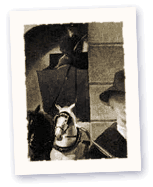 |
 | |||
|
The Fenian Movement
Stephens had now lost influence, and it was left to civil war veterans, notably Thomas Kelly, to instigate a rising in March 1867. It was no more effective than the 1848 fiasco. Kelly had made his headquarters in England, where Fenianism had strong support among Irish emigrants, Other Fenian prisoners were treated more leniently, with death sentences being commuted. However, the execution of the Manchester martyrs, for what was perceived as an accidental killing, aroused great anger among Irish people at home and abroad. Equally, there was a growth of anti-lrish feeling in England, particularly in December 1867, when a number of Londoners were killed or severely injured when a Fenian bomb exploded during a rescue attempt at Clerkenwell prison.
Almost fifty years would pass before the next rising in Ireland, and during this period the main thrust of Irish nationalism was provided by a parliamentary campaign for home rule. However, the Irish Republican Brotherhood preserved the ideal of total separation from Great Britain, and some Fenians were active in new organisations like the Land League and the Gaelic League. Of more immediate importance, though, the Fenian rising had further persuaded some British politicians that the Irish problem called for radical measures. Among them was a future prime minister, William Ewart Gladstone.
From Irish Battles - A Military History of Ireland by G.A.Hayes-McCoy. Click here for more information on the book. Further reading: A Little History of Ireland by Martin Wallace with illustrations by Ian McCullough. Click here for more information on the book.
|
[ Back to top ]
All Material © 1999-2018 Irelandseye.com and contributors

 and had earlier failed in an attack on Chester Castle to capture arms and ammunition. He and another Fenian were arrested in Manchester on 11 September. A week later, they were rescued while being taken from court to gaol. A police officer was shot dead, and three Fenians were subsequently hanged for his murder. They became known as the Manchester martyrs, and their words from the dock, "God save Ireland", were soon embodied in a popular patriotic ballad.
and had earlier failed in an attack on Chester Castle to capture arms and ammunition. He and another Fenian were arrested in Manchester on 11 September. A week later, they were rescued while being taken from court to gaol. A police officer was shot dead, and three Fenians were subsequently hanged for his murder. They became known as the Manchester martyrs, and their words from the dock, "God save Ireland", were soon embodied in a popular patriotic ballad.